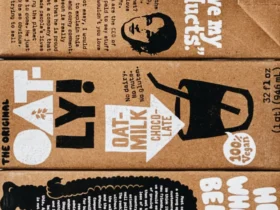Hello, my friends! I hope this post finds you well. Today, I’m excited about diving into a recent topic that sparked my curiosity – the oat milk vs. cow milk debate.
I remember the first time I tried oat milk. On one of those cold, rainy afternoons, my friend insisted I swap the regular cow’s milk in my latte for oat milk. I must admit, as a lifelong, full-fat, frothy cow’s milk advocate, I was skeptical. In my mind, there was no way this trendy “vegetable milk” could replace the creamy comfort provided by cow’s milk. But I thought, why not just give it a whirl?
What followed was nothing short of a delightful surprise. The oat milk tasted incredible. It had this lovely, silky texture and a gentle sweetness that made my latte feel like a warm hug. It felt familiar yet new all at the same time. “Wow, this is different, but I could get used to it,” I thought to myself.
From that day, I was on a mission to explore these two milk variants further, and I’ve finally consolidated all my research and personal experiences into this piece for you. Many of us might be facing a similar crossroads, whether cruising the grocery aisles or ordering your favorite coffee from the local café – should you switch to oat milk or stick with good old cow’s milk?
So, what’s the real deal? In this blog post, we’ll take a deep dive into the world of these two milks, unraveling their twists and turns. The goal? To help you make an informed decision based on your dietary preferences, health considerations, and more.
Oat Milk: A Sustainable and Plant-Based Option
Did you know that oat milk has a 75% smaller carbon footprint than dairy milk? Yes, that’s correct. With oat milk, you’re casting a vote for a more sustainable planet with each delicious, creamy sip!
According to a study published in the journal Science, dairy milk generates nearly three times more greenhouse gas emissions than any plant-based milk alternative (1). Additionally, the Student Voices from Columbia University in the city of New York states that producing 1 liter of cow’s milk requires approximately 1,050 liters of water. In contrast, oat milk requires only 48 liters (2). This comparison becomes more striking when considering that around 33% of the global water footprint of agriculture can be attributed to animal products.
With climate change becoming a more pressing concern, choosing plant-based alternatives like oat milk can help reduce our environmental impact and lessen the demand for global water resources.
Cow Milk: Tradition

Let’s not forget the cultural legacy and nutritional goodness cow milk brought to our breakfast tables over the ages. It’s an excellent source of protein, calcium, and vitamins, cornerstones for our well-being. And who can deny the creaminess it imparts to our favorite dishes?
But, as we evolve, it’s crucial to consider the potential drawbacks of this long-loved beverage. Lactose intolerance, for instance, affects about 65% of the global population post-infancy, making cow milk a touchy affair for many tummies.
Cow milk is known for its protein, calcium, and vitamin richness. However, a cup (240 ml) of fortified oat milk can provide a similar nutrient profile. According to the USDA National Nutrient Database, fortified oat milk contains about 3.3 g of protein per cup, compared to 8 g in cow milk (3). While cow milk has more protein, most people get enough through various sources in their diet.
Calcium and vitamins found in cow milk can also be obtained through fortified plant-based milk alternatives. When choosing oat milk, ensure it’s fortified to ensure you’re getting these essential nutrients.
Health Considerations: Comparing Nutritional Values
Switching gears to nutritional values: oat and cow milk has it’s respective unique selling points. Cow milk edges out with higher protein content, but don’t count oat milk out! According to the National Institutes of Health, around 65% of the global population has a reduced ability to digest lactose after infancy (4).
Oat milk holds its own as a fibrous play player, something cow milk lacks. So, in reality, they are different sides of the same coin, each serving a different purpose. Also, in the allergen corner, oat milk certainly stands tall, being naturally lactose-free!
Below is a full breakdown of Oat Milk vs. Cow Milk:
| Property | Oat Milk | Cow Milk |
|---|---|---|
| Source | Plant-Based | Animal-Based |
| Allergies | Gluten-free, nut-free | Potential for lactose intolerance |
| Protein | Moderate | High |
| Fat | Low | Low-High |
| Fiber | High | None |
| Calcium | Often Fortified | Natural source |
| Lactose-Free | Yes | No (Unless lactose free milk) |
| Sustainability | High | Low |
| Suitable for | Vegans, lactose intolerant | Not suitable for lactose intolerant, vegans |
| Taste | Smooth, sweet | Classic, creamy |
| Price | Generally more expensive | Generally cheaper |
Taste and Texture: Are They Comparable?
After immersing myself in the creamy delight that oat milk is, I can certainly vouch for its splendid experience. It’s slightly sweeter with a fuller body that goes hand in hand as a companion to your cereals, a cup of latte, and even soups and sauces.
As wonderful as my personal taste experience was, I always encourage my readers to dive in and explore the world of taste independently. Go ahead, pour yourself a glass of oat milk, and let your taste buds decide!
Buying Oat Milk: Tips and Recommendations

Here are a few quick tips before you run to get your oat milk. Look out for brands that are minimal on additives, especially sugars. I’ve found Oatside and Oatly to deliver pretty well on the taste and nutrition front.
Most supermarkets would have oat milk these days. But just in case yours doesn’t, online marketplaces got you covered!
Oatside: OATSIDE Oat Milk (International) | OATSIDE Oat Milk 1L (Malaysia)
Oatly: OATLY Oat Milk (International) | OATLY Oat Milk 1L (Malaysia)
In Closing
We’ve had quite a journey exploring the oat milk and cow milk landscape. While it might seem complicated, remember it boils down ultimately to personal preference and nutritional needs. By considering these factors and making informed decisions, consumers can adopt a more sustainable and suitable diet for their individual lifestyles
Give it a shot, sip it, cook with it, bake with it, and see how it goes! Remember, with every small step you take towards conscious choices, the world and I thank you. Here’s to a glass full of sustainability, nutrition, and creamy deliciousness!
Sources
1. Poore, J., & Nemecek, T. (2018). Reducing food’s environmental impacts through producers and consumers. Science, 360(6392), 987–992. https://science.sciencemag.org/content/360/6392/987
2. Taylor Goto. (2021). How Oat Milk Can Help Save the Environment https://climatesociety.ei.columbia.edu/news/how-oat-milk-can-help-save-environment
3. USDA National Nutrient Database for Standard Reference, Legacy Release. https://fdc.nal.usda.gov/
4. Genetics Home Reference: Lactose intolerance. (2021). https://ghr.nlm.nih.gov/condition/lactose-intolerance#statistics






Leave a Reply